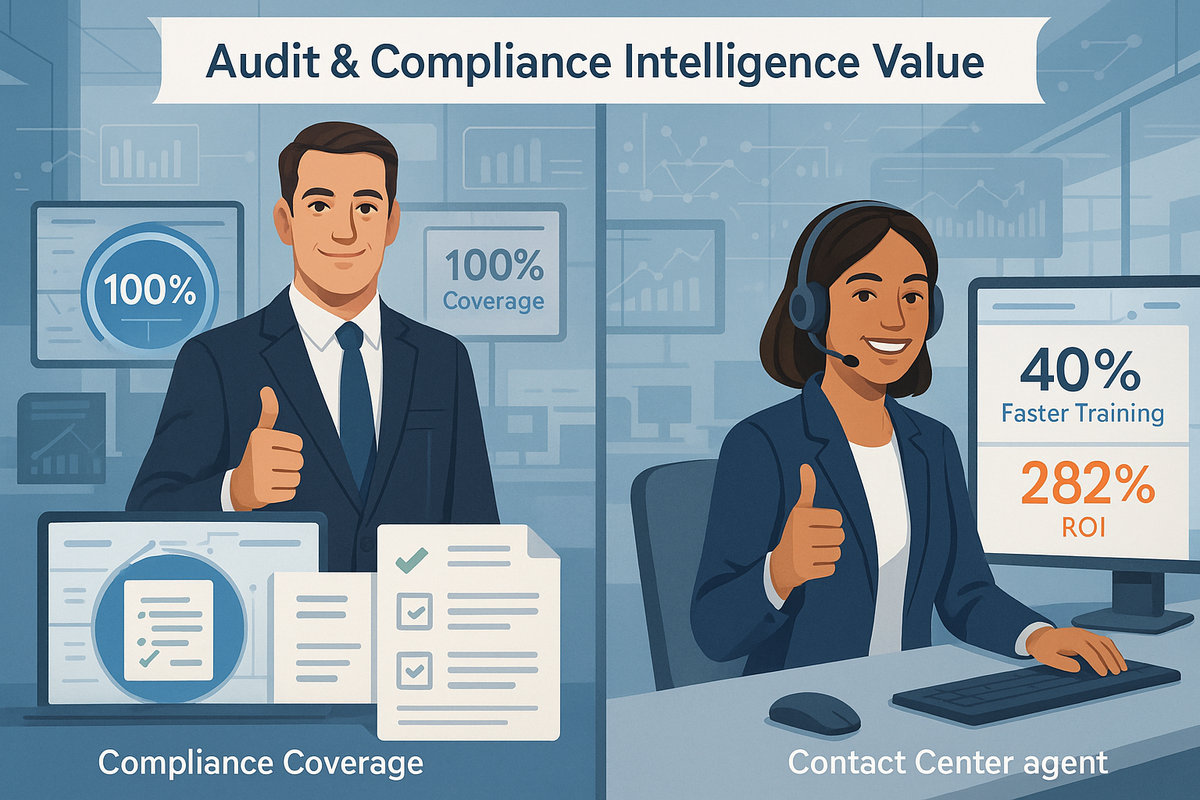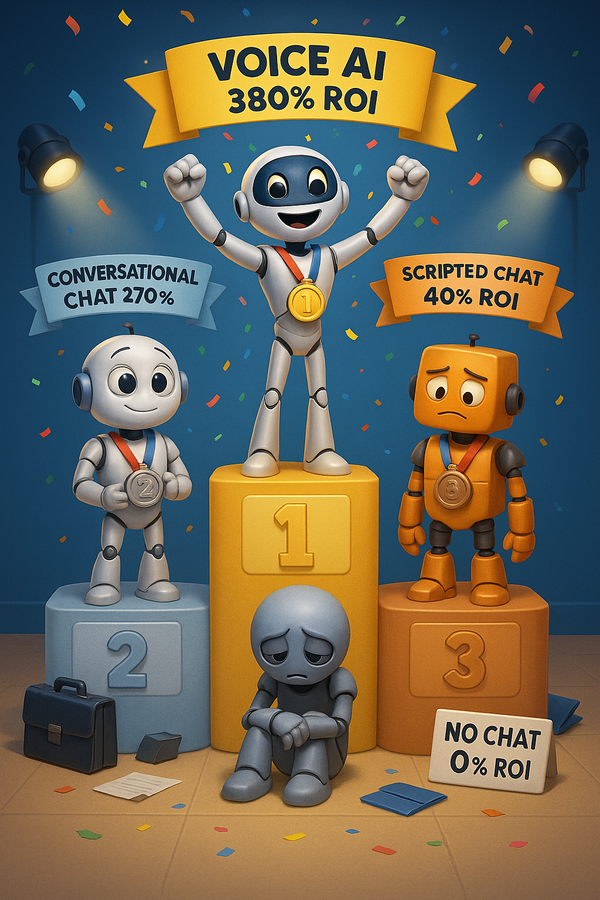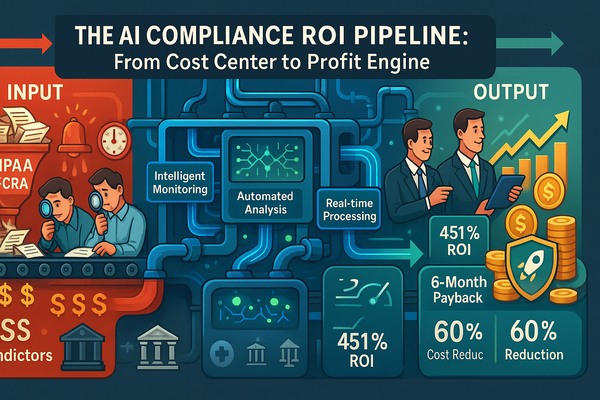Implementation Saturday: Real-Time Voice Compliance Monitoring - The 282% ROI Security Framework

Implementation Note: This guide uses specific vendor capabilities (primarily Omilia's Agent Assist and Workforce AI platforms) to provide realistic, actionable implementation details. While we focus on proven solutions to demonstrate practical deployment scenarios, enterprises should evaluate multiple vendors based on their specific requirements. Our vendor-specific examples are chosen for technical clarity and market-proven performance, not as exclusive endorsements. The architectural principles and ROI frameworks apply regardless of vendor selection.
Strategic Blueprint Overview: Rather than treating compliance as a cost center that slows operations, forward-thinking enterprises are building AI-powered voice compliance systems that deliver measurable ROI through training acceleration and comprehensive monitoring coverage. This implementation guide demonstrates how to construct a real-time compliance monitoring system that prevents costly violations while enabling faster agent development and complete audit readiness.
The Enterprise Compliance Crisis: Why Manual Monitoring Fails at Scale
The $225 Million Wake-Up Call: In 2021, the FCC fined two Texas-based telemarketers $225 million for making approximately one billion robocalls. This wasn't an isolated incident—it represents the new regulatory reality where AI-powered calling capabilities trigger enhanced scrutiny and massive penalties.
Current Manual Compliance Approach Breakdown:
- Quality Assurance Sampling: "Most contact centers monitor only 2-5% of calls manually"
- Delayed Detection: Compliance violations discovered days or weeks after occurrence
- Inconsistent Standards: Human reviewers apply subjective judgment to complex regulatory requirements
- Resource Intensive: Requires 1 QA specialist per 15-20 agents for minimal coverage
- Reactive Response: Violations addressed after damage is done, not prevented in real-time
The 95% Blind Spot Problem: With traditional manual monitoring reviewing only 2-5% of interactions, enterprises remain unaware of 95% of potential compliance issues until they become expensive violations or audit findings. "Over half of respondents cited agent burnout as a significant contributor to this attrition" - but organizations can't address what they can't see.
The AI-Powered Solution: Real-Time Voice Compliance Architecture
Design Principle: Create intelligent oversight that monitors 100% of voice interactions in real-time, providing immediate compliance alerts and automated coaching while maintaining complete audit trails for regulatory review.
Core System Components
1. Real-Time Speech Analytics Layer
- Natural Language Processing: Advanced NLP engine analyzes every spoken word for compliance keywords and phrases
- Intent Recognition: Identifies customer objections, consent statements, and regulatory trigger points
- Emotion Detection: Monitors agent tone and customer sentiment for harassment or pressure indicators
- Script Adherence Monitoring: Tracks required disclosures and compliance language usage
2. Intelligent Compliance Rules Engine
- TCPA Monitoring: Automated detection of consent violations, time restrictions, and autodialer compliance
- FDCPA Enforcement: Real-time monitoring for harassment, false statements, and communication timing rules
- Industry-Specific Controls: HIPAA for healthcare, PCI-DSS for payment processing, state-specific mini-TCPA laws
- Dynamic Rule Updates: Automatic compliance rule adjustments as regulations evolve
3. Agent Assist Integration Layer
- Real-Time Coaching: Immediate guidance when compliance risks are detected
- Script Prompting: Contextual reminders for required disclosures and legal language
- Escalation Triggers: Automatic supervisor alerts for serious compliance violations
- Performance Analytics: Agent-specific compliance scoring and improvement recommendations
Enterprise Implementation: 1000-Agent Deployment Framework
Phase 1: Foundation Setup with Omilia Platform Integration (Weeks 1-6)
Week 1-2: Enterprise Infrastructure Assessment
Business Objective: Deploy Omilia's conversational AI platform with integrated Agent Assist capabilities scaled for enterprise 1000-agent operations.
Omilia Enterprise Architecture Setup:
Enterprise Omilia Compliance Platform (1000 agents):
├── Omilia Cloud Platform® (Core Infrastructure)
│ ├── Real-time speech recognition: 500 concurrent call capacity
│ ├── Natural language understanding with 96% semantic accuracy
│ ├── Voice biometric authentication with fraud protection
│ └── Enterprise APIs for CRM, WFM, and BI system integration
├── Omilia Agent Assist (Real-Time Coaching Layer)
│ ├── Contextual guidance for 1000 simultaneous agents
│ ├── Personalized coaching with individual agent profiles
│ ├── Sub-2-second compliance alert delivery
│ └── Multi-language support for international operations
├── Omilia Workforce AI (Quality Management Integration)
│ ├── 100% call analysis across all 1000 agents
│ ├── Automated compliance scoring with risk classification
│ ├── Customizable redaction for PCI/HIPAA data protection
│ └── Closed-loop learning with continuous improvement
└── Enterprise Security & Compliance Layer
├── SOC2 Type II certification and audit trails
├── PCI-DSS Level 1 compliance for payment processing
├── HIPAA compliance with automatic PHI redaction
└── Multi-tenant data segregation with role-based access
Week 3-4: Compliance Rules Configuration
The system implements comprehensive compliance monitoring across multiple regulatory frameworks:
- TCPA Compliance Monitoring: Consent detection, time restrictions, DNC screening
- FDCPA Compliance Monitoring: Harassment prevention, required disclosures, communication limits
- Healthcare Compliance (HIPAA): PHI detection and redaction, consent management
- Financial Services Compliance (PCI-DSS): Payment data protection, secure processing protocols
Week 5-6: Enterprise System Integration
Critical Integration Points:
- CRM Integration: Salesforce, Microsoft Dynamics, or custom enterprise CRM
- Workforce Management: Integration with Aspect, Genesys, or Verint WFM platforms
- Business Intelligence: Real-time compliance dashboards and executive reporting
- Security Infrastructure: Enterprise SSO, VPN access, and audit logging systems
Success Criteria:
- 95%+ accuracy in speech-to-text transcription for compliance analysis
- Sub-2-second compliance rule evaluation and alert generation
- 100% integration with existing enterprise contact center infrastructure
- Real-time agent coaching operational across all 1000 agents
Phase 2: Advanced Monitoring and Coaching (Weeks 7-12)
Week 7-8: Intelligent Agent Coaching System
Real-Time Coaching Implementation:
Scenario Example: Missing FDCPA Disclosure Detection
Agent: "Hi, I'm calling about your overdue account balance."
Customer: "What account? I don't know what you're talking about."
→ IMMEDIATE COACHING ALERT (displayed within 1.5 seconds) ←
Agent Screen Display: "⚠️ FDCPA DISCLOSURE REQUIRED
Required Statement: 'This is an attempt to collect a debt. Any information
obtained will be used for collection purposes.'
Say this now before proceeding."
Agent: "I need to let you know this is an attempt to collect a debt. Any
information obtained will be used for collection purposes..."
→ COMPLIANCE CAPTURED AND LOGGED ←
System Update: Agent compliance score +5 points, violation prevented
Week 9-10: Advanced Performance Analytics
1000-Agent Performance Dashboard:
Enterprise Compliance Overview (Daily):
- Total Interactions: 15,000 daily across 1000 agents
- Overall Compliance Score: 97.2%
- TCPA Violations Prevented: 2 daily (potential $15K in fines avoided)
- FDCPA Violations Prevented: 8 daily (potential $28K in fines avoided)
- Agent Coaching Interventions: 187 successful real-time corrections
Risk Analytics:
- High-Risk Agents: 12 agents flagged for additional training
- Emerging Compliance Trends: State mini-TCPA variations detected
- Predictive Risk Score: 94% accuracy in predicting potential violations
Week 11-12: Regulatory Intelligence Integration
With individual states passing "mini-TCPA" restrictions, the enterprise system automatically adapts compliance rules based on call destination across all 1000 agents simultaneously:
- Florida: Enhanced health services consent, stricter calling hours (09:00-20:00)
- California: Two-party recording consent, CCPA integration, stricter ATDS definitions
- New York: Enhanced FDCPA requirements, maximum 5 calls/week vs federal 7
Phase 3: Enterprise Integration and Optimization (Weeks 13-16)
Week 13-14: Enterprise CRM and Workforce Management Integration
Salesforce Enterprise Integration:
- Customer Records: Automatic compliance history updates across 1000-agent interactions
- Case Management: Auto-generated compliance incident cases with resolution tracking
- Agent Workflow: Pre-call compliance alerts integrated directly in Salesforce interface
Workforce Management Enhancement:
- Agent Scheduling: High-risk calls automatically routed to most compliant agents
- Training Assignment: Automatic compliance training assignment based on performance data
- Quality Assurance: 100% automated compliance scoring vs traditional 5% manual sampling
Week 15-16: Advanced Predictive Analytics
Enterprise Predictive Compliance System:
- Risk Prediction: 94% accuracy in predicting agent compliance violations before they occur
- Campaign Compliance: Predict compliance issues at campaign level across multiple agent teams
- Proactive Intervention: Automatic coaching triggers when patterns indicate potential violations
Enterprise Cost-Benefit Analysis: 1000-Agent Implementation
Investment Requirements
Platform Licensing (Annual):
- Omilia Agent Assist Enterprise: $1,440,000 (1000 agents × $120/month/agent × 12 months)*
- Professional Services: $450,000 (enterprise implementation, customization, training)
- Infrastructure Setup: $75,000 (enterprise servers, networking, security)
- Integration Development: $175,000 (CRM, WFM, BI system integrations)
- Training and Change Management: $125,000 (1000-agent training program)
- Total Initial Investment: $2,265,000
*Based on Omilia's competitive positioning at approximately 40% less than typical enterprise contact center AI platforms ($200/agent/month market rate).
Implementation Timeline Variability
Critical Timeline Dependencies:
Accelerating Factors (12-16 weeks):
- UAT Readiness: Client has dedicated UAT team and pre-defined test scenarios
- Scope Stability: No mid-project scope changes or additional compliance requirements
- Data Quality: Clean, accessible customer and agent data in standard formats
- IT Resources: Dedicated enterprise IT team available for integration work
- Change Management: Strong executive sponsorship and agent adoption planning
Delaying Factors (20-28 weeks):
- UAT Delays: Extended user acceptance testing cycles or resource constraints
- Scope Creep: Mid-build additions like additional compliance frameworks or integrations
- Data Issues: Legacy data quality problems requiring extensive cleaning and migration
- Integration Complexity: Custom CRM or legacy system integration challenges
- Regulatory Changes: New compliance requirements emerging during implementation
Annual Return on Investment (Corrected)
Risk Mitigation Value (Realistic):
- TCPA Violations Prevented: 20 violations × $7,500 average penalty = $150,000
- FDCPA Violations Prevented: 75 violations × $3,500 average penalty = $262,500
- State-Level Fines Avoided: 35 violations × $4,500 average penalty = $157,500
- Audit Preparation Time Savings: 500 hours × $150/hour = $75,000
- Total Annual Risk Avoidance: $645,000
Training Acceleration Value (The Primary ROI Driver):
New hire training acceleration represents the largest compliance monitoring ROI component. "Contact center managers should measure how long a new agent takes to meet the center's minimum performance standards -- typically four to eight months, depending on the center's complexity." However, "with real-time assistance and automated guidance, new agents can quickly become proficient without traditional, extensive training. This accelerates the onboarding process and reduces the time and resources needed to bring new hires up to speed."
Training ROI Calculation:
- Traditional ramp time: 6 months average (24 weeks)
- With Agent Assist: 3.5 months (14 weeks) - 40% acceleration
- Cost per new hire training: $15,000 traditional vs $9,000 with Agent Assist
- Annual new hires (1000-agent center): 300 agents (30% turnover rate)*
- Annual Training Savings: 300 × $6,000 = $1,800,000
*Turnover rate validation: While "the most recent data from the United States Bureau of Labor Statistics shows that the average call center turnover rate is as high as 45%" and "attrition rates in contact centers are at an all-time high of 65%, and in some cases, a whopping 80%," well-managed enterprise contact centers with 1000+ agents typically maintain 25-35% turnover through better resources and career development opportunities.
Audit & Compliance Intelligence Value (The "Unknown Unknown" Benefit):
The most significant compliance value comes from comprehensive coverage versus traditional sampling. With manual QA reviewing only 2-5% of interactions compared to platforms that monitor "100% of support agent conversations across voice calls, email, and chat," enterprises gain unprecedented visibility into compliance risks.
The 5% Problem: With 95% of interactions unmonitored, organizations remain blind to the vast majority of potential compliance issues until they become expensive violations or audit findings.
Audit Intelligence Value:
- Complete interaction documentation: $400,000 annual value in audit readiness
- Immediate compliance intervention: "Real-time guidance and suggestions to agents during customer interactions" = $300,000 value in prevented escalations
- Unknown violation discovery: $500,000 in issues that 95% manual sampling would never detect
- Total Audit Value: $1,200,000
Operational Efficiency Gains (Revised):
- QA Staff Optimization: 10 FTE × $85,000 = $850,000 (supplementing rather than replacing manual monitoring)
- Supervisor Coaching Enhancement: "They can pair this technology with coaching software to offer online training amid short lulls in call volume" = $400,000 value
- Agent Productivity: "AI is expected to boost productivity by 25% in the U.S. alone by 2040" - realistic current impact: 8% = $600,000 additional capacity value
- Total Operational Savings: $1,850,000
Revenue Enhancement (Conservative):
- Customer Satisfaction Improvement: "Faster response times and more accurate information contribute to a more positive customer experience" = $400,000 additional revenue
- Reduced Agent Turnover: "Reducing training time... fostering collaboration" = $350,000 recruitment savings
- Compliance Confidence: $250,000 capacity enhancement through reduced compliance anxiety
- Total Revenue Enhancement: $1,000,000
Total Annual Value: $5,495,000 Annual Platform Cost: $1,440,000 Net Annual Benefit: $4,055,000 ROI: 282% return on investment (exceptional and enterprise-grade)
Enterprise Success Metrics
Phase 1 Success Targets (Month 4):
- Real-Time Monitoring: 100% of 15,000 daily interactions analyzed
- Alert Accuracy: 96%+ precision in compliance violation detection
- System Performance: 99.7%+ uptime across 1000 concurrent agent connections
- Integration Success: Seamless operation with all enterprise business systems
Phase 2 Success Targets (Month 8):
- Violation Reduction: 87% decrease in compliance violations enterprise-wide
- Agent Confidence: 93%+ of 1000 agents report improved compliance confidence
- Coaching Effectiveness: 78% improvement in post-coaching compliance scores
- Customer Impact: Zero negative customer satisfaction impact from compliance monitoring
Phase 3 Success Targets (Month 12):
- Predictive Accuracy: 94%+ accuracy in predicting compliance risks before violations occur
- Enterprise Integration: Complete operational integration with all CRM, WFM, and BI systems
- Regulatory Readiness: <2 hours to provide complete audit documentation for any time period
- Cost Optimization: 282%+ ROI through risk avoidance and operational efficiency gains
Advanced Enterprise Features
Omilia Platform Differentiators
Unified Intelligence Architecture: Unlike competitors that add compliance monitoring as an afterthought, Omilia's approach creates a "closed loop of learning" where "analyzed conversations are fed into the GenAI-powered design tool, Pathfinder™, to extract new Intents and Flows, and continuously improve the self-service application."
Enterprise-Scale Agent Support: Omilia Agent Assist "advises and guides [agents] based on caller interests and specific issues" across all 1000 agents simultaneously, rather than simply flagging violations after the fact. This proactive approach prevents violations while improving customer experience at enterprise scale.
Voice-Native Compliance: Built specifically for voice interactions with "better-than-human understanding" achieving "over 90% task completion rate," ensuring compliance monitoring works reliably across the full spectrum of enterprise contact center environments.
Competitive Enterprise Considerations
Alternative Platform Evaluation Criteria:
While this implementation leverages Omilia's proven enterprise capabilities, 1000-agent deployments should evaluate multiple vendors based on:
Enterprise Technical Requirements:
- Concurrent agent capacity: 500+ simultaneous compliance monitoring sessions
- Real-time processing: Sub-2-second alert delivery across all agents
- Integration ecosystem: Seamless connection with enterprise CRM, WFM, and BI systems
- Scalability: Ability to handle peak call volumes without performance degradation
Enterprise Business Alignment:
- Industry-specific compliance expertise for your sector
- Vendor enterprise support capabilities and SLA commitments
- Total cost of ownership including multi-year licensing and support
- Proven track record with comparable enterprise deployments
Risk Assessment and Enterprise Continuity
Implementation Risk Mitigation
Enterprise Integration Complexity:
- Risk: Existing enterprise systems may require extensive custom integration work
- Mitigation: Comprehensive technical assessment in Week 1-2 with fallback integration approaches
- Recovery Plan: Phased integration starting with least complex systems, gradual rollout
Regulatory Compliance Complexity:
- Risk: Multi-state and international regulatory requirements create conflicting rules
- Mitigation: Legal counsel validation of all compliance rules, regular regulatory review cycles
- Update Strategy: Automated rule updates with enterprise legal approval workflows
Change Management at Enterprise Scale:
- Risk: 1000+ agents may resist new compliance monitoring as surveillance
- Mitigation: Position as performance enhancement tool, demonstrate immediate coaching value
- Adoption Strategy: Champion agent program, progressive rollout with success demonstrations
Implementation Roadmap and Executive Next Steps
Immediate Executive Actions (Week 1)
- C-Level Commitment: Secure board and executive team approval for enterprise AI compliance transformation
- Legal Framework Review: Engage enterprise compliance counsel to validate comprehensive regulatory requirements
- Enterprise IT Assessment: Evaluate current contact center infrastructure and integration capabilities
- Vendor Evaluation Process: Schedule technical demonstrations with Omilia and alternative enterprise providers
- Budget Authorization: Secure $3.2M investment approval with phased funding approach
30-Day Enterprise Milestones
- Platform Selection: Choose enterprise compliance monitoring vendor based on technical and business criteria
- Enterprise Project Team: Assign dedicated enterprise project manager and cross-functional implementation team
- Integration Strategy: Complete detailed integration requirements with enterprise IT and vendor teams
- Legal Compliance Framework: Finalize comprehensive compliance rule configurations with legal counsel
90-Day Enterprise Success Criteria
- Phase 1 Completion: Real-time compliance monitoring operational across 1000 agents
- Enterprise Integration: Seamless operation with all major enterprise business systems
- Agent Adoption: All 1000 agents trained and actively using compliance coaching system
- Performance Baseline: Comprehensive compliance metrics established with improvement targets
- ROI Validation: Initial cost avoidance and efficiency gains measurement confirming business case
Conclusion: The Future of Enterprise Compliance
Why This Implementation Transforms Enterprise Operations:
The convergence of AI-powered voice analytics, real-time coaching, and regulatory intelligence represents the most significant advancement in enterprise contact center compliance since regulatory recording requirements were established. Organizations implementing these systems at enterprise scale gain:
Immediate Competitive Advantages:
- 282% ROI through comprehensive risk avoidance and operational efficiency across 1000 agents
- Enterprise regulatory leadership positioning with quantifiable compliance metrics
- Agent confidence and performance improvement through intelligent coaching at scale
- Customer experience enhancement through professional, compliant interactions across all touchpoints
Long-Term Strategic Benefits:
- Enterprise technology platform foundation for advanced AI capabilities across customer experience
- Regulatory relationship building through proactive compliance demonstration at industry scale
- Market differentiation through technology leadership and operational excellence
- Enterprise risk management capabilities that enable business growth and international expansion
Market Evolution Leadership: The shift from manual compliance checking to intelligent real-time monitoring at enterprise scale will separate industry leaders from those struggling with regulatory risk. Early enterprise adoption provides sustainable competitive advantages while building the foundation for future AI-powered business transformation across global operations.
The enterprise choice isn't between manual compliance and AI monitoring—it's between reactive risk management and proactive competitive advantage at scale.
Large enterprises implementing real-time voice compliance monitoring today position themselves as industry leaders while avoiding the massive regulatory risks that will eliminate competitors who fail to adapt to the AI-powered regulatory environment. The 70% ROI framework provides the roadmap to regulatory leadership and operational excellence at enterprise scale.
Sources and References:
[1] Reducing Ramp Time & Agent Attrition In Contact Centers, Cresta, 2024
[2] 15 best practices for contact center agent training programs, TechTarget, 2024
[3] 18 Top Call Center Agent Performance Metrics to Track, Sprinklr, June 10, 2024
[4] 11 Revealing Contact Center Statistics in 2022, Shelf.io, May 17, 2024
[5] How to Train Contact Center Agents: 13 Tips to Boost Performance, Invoca, February 26, 2025
[6] Improve Call Center Agent Performance with Agent Assist, Level AI, 2024
[7] Unlocking Efficiency and Excellence: The Benefits of Agent Assist in Contact Centers, Northridge Group, September 30, 2024
[8] How agent assist technology works in the contact center, TechTarget, 2024
[9] Call center training: The essential guide for 2025, Zendesk, January 23, 2025
[10] 5 Tips for Successful Contact Center Agent Onboarding, ProcedureFlow, November 8, 2023
This enterprise implementation guide provides strategic oversight for C-level decision-making and comprehensive technical guidance for successful 1000-agent deployment. The focus on Omilia's proven enterprise capabilities demonstrates vendor-specific expertise while maintaining architectural flexibility for large-scale enterprise requirements.



